7/20/2011 2:20:00 PM
Back Stretching Exercises
Note: If you have a back injury or condition or back pain, consult a physiotherapist who can advise you what exercises and how many repetitions of each exercise would be the safest and most beneficial for you.
How Often to do Stretching Exercises
Stretching exercises may be done daily but every second day is usually enough. Specific stretches are often recommended twice daily for those suffering from sciatica or other types of back pain or stiffness. A physician or physical therapist should be consulted if you are experiencing back pain, as the prescribed exercises will vary according to the cause of the pain.
How Long to Hold a Stretch
For stretching exercises, the total time stretching a muscle should generally be about 60 to 90 seconds. Holding a stretch for 30 seconds only requires 2 or 3 repetitions. Holding a stretch for 5 or 10 seconds of course requires more repetitions. The optimal amount of time to hold a stretch to achieve best results is not an exact science - even a single 10-second stretch may have some benefits, although a minimum of thirty seconds in total for stretching each muscle is generally recommended.
Note: You should feel a gentle stretch / tension on the muscles you are stretching. You should NOT feel pain.
Always warm up before stretching exercises. Five minutes of walking, or exercise bike, elliptical trainer, or even marching on the spot is enough. Not warming up before stretching leaves your back susceptible to injuries. Warm muscles are more flexible than cold muscles and are less likely to tear.
*Check with your physician before doing exercises that involve twisting or arching the back if you have a back condition.
Keep Breathing. Do not hold your breath!
Pelvic Tilt: lower back stretching exercise and abs strengthening exercise
Lie on back, knees bent, feet flat on floor. Take a deep breath. Exhale as you flatten the small of your back against the floor (or as close at you can get). Do not push feet into floor to assist with the move - use your abs. Hold for a count of five. Slowly relax. Repeat five - fifteen times.
NOTE: Exhale as you pull your back toward the floor: inhale as you relax.
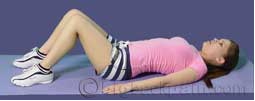
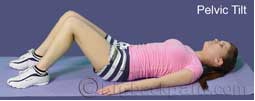
Basic Spinal Twist: lower back stretching exercise
Lie on back, arms stretched out to the sides.
Bend knees and place feet flat on floor.
Slowly lower knees (keep knees together) to floor to one side as close to the floor as is comfortable.
Hold the stretch for 15-30 seconds.
Repeat on opposite side
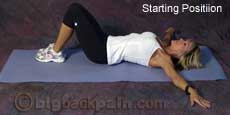
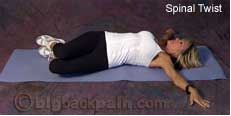
The Cat: back stretching exercise
Begin on all fours, hands directly under your shoulders and knees directly under your hips.
Inhale as you drop tummy towards the floor and look up over your head.
Exhale as you bring your tummy back up, rounding your back as you tuck your chin in and tuck your tailbone in.
Move slowly back and forth between these two positions pausing on each pose.
Repeat about 5 times.
The Cobra: abdominal, lower back and chest stretching exercise
Lay flat on stomach, forehead to ground, with arms bent and palms down on the ground under the shoulders.
Push downward with arms as you raise your upper torso and arch your back.
Hold for 3 full breaths before slowly bringing the upper torso back down to the ground.
Shoulder, Back, Arms Stretch
Stand with knees slightly bent. Interlace fingers, extend arms forward at shoulder level. Turn palms out and reach your arms further until you feel a stretch. Hold 30 seconds. .
Chest Stretch
Stand with knees slightly bent. Hands behind the back, fingers interlaced. Turn palms up extend arms backward. Do not arch the back. Hold 30 seconds.
Sides, Waist Stretch
Stand with knees slightly flexed. (Can also be done sitting down) Place your right hand behind your head. Grab your right elbow with your left hand and pull gently. Bend slowly to the left until you feel a gentle stretch. Hold stretch 30 seconds. Switch sides and repeat.
Knee to Chest: Gluteal / lower back stretching exercise
Lie on back, knees bent, feet flat on floor. Grasp left leg behind the knee/back of thigh and pull knee towards chest. (Right leg may be either bent with foot flat on floor or straight with leg on floor to simultaneously stretch front of right hip) Hold 30 seconds. Switch sides and repeat.

Piriformis Stretch: (Stretches Muscles that lie beneath gluteal muscles)
Sit on chair
Place your left ankle over your right leg, just above the knee and lean forward.
Hold for 30 seconds. Switch sides and repeat.
Note: Three hamstring stretches are shown. Pick one.
Hamstring (back of thigh) Stretch
Sitting on floor, extend right leg, place left foot against right knee. Lean forward (keeping back straight), reaching for foot until you feel a slight pull on you hamstring. Hold for 30 seconds. Switch sides and repeat.
Hamstring (back of thigh) Stretch
Lying flat on back. Raise left leg up. Grab leg and pull up further until you feel a gentle pull in the hamstring. Hold for 30 seconds. Switch sides and repeat.
Hamstring (back of thigh) Stretch
Stand in front of chair or stool or any elevated surface. Place left leg on chair keeping leg straight Bend forward at the hip, keeping back straight. Hold stretch for 30 seconds. Switch sides and repeat.
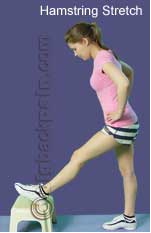 Shortened hip flexors and quadriceps can contribute to sway back
Shortened hip flexors and quadriceps can contribute to sway back
Hip Flexor Stretch
Kneel on mat. Bend right leg and place right foot ahead of you on floor, knee lined up over ankle. Left leg (knee to toes) remains on floor behind you (place a cushion under the knee if mat does not provide enough cushioning). Keep Back Upright. Lean forward from the hip slightly - until you feel a stretch in the front of the left hip and upper thigh. Do not extend knee beyond toes. Tighten left buttock and tuck the tailbone under to increase the stretch. Remember to keep back upright. Hold stretch for 30 seconds. Switch sides and repeat.
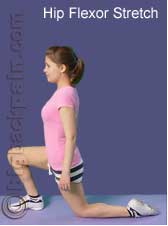
Quadriceps (front of thigh) Stretch
Stand up. Bend your knee behind you, grab your ankle and gently pull your heel toward you buttocks until you feel a gentle pull on the front of your thigh. Hold for 30 seconds. Switch sides and repeat.
Wall Back Stretch: back / neck stretching exercise
Stand up with your back against the wall. Very gently press the small of your back and the back of your neck toward the wall. Hold for 30 seconds. Do not overstretch!
Stretching using an Inversion Table
Inversion therapy has been around for a couple of thousand years. Your feet are securely supported as your body hangs upside down - and the spine is stretched by the weight of your body.
Back Strengthening Exercises
Note: If you have a back injury or condition or back pain, consult a physiotherapist who can advise you what exercises and how many repetitions of each exercise would be the safest and most beneficial for you.
Many people tend to overdo it when starting strengthening exercises for the back, resulting in back strain. Back pain caused by doing too much too soon sets one back even farther. But the ultimate goal is to be able to do the back strengthening exercises. Strengthening the back can't be rushed. It takes patience but it is well worth the effort.
How Often to do Strengthening Exercises
Strengthening exercises should be done about every second day (for the same muscle group) - the days off give your body a chance to recover. Strengthening exercises done daily can result in overuse injuries. It may take 6 week to 8 weeks to notice results.
How Many Repetitions and Sets
When starting strengthening exercises, begin with five repetitions (or less if your find the exercise difficult) of each exercise. If you can handle five repetitions without post exercise pain, then slowly add a couple of repetitions each week until you reach 10 - 15 repetitions. Although even one set of 10 - 15 reps is beneficial, to further increase endurance add a second set of 10 -15 repetitions after you can handle one set. In time, add a third set. Rest for about 30 - 60 seconds between sets. If the exercise involves holding your body in one position for the entire exercise (a static exercise), then 60 seconds is equivalent to one set.
Note: Strengthening exercises (for the same muscle group) should not be done on consecutive days. Overuse injuries can result. Every second day or 3 times a week is fine.
Warning: Do not hold your breath! Holding your breath can cause a spike in blood pressure! Concentrate on breathing while exercising.
Warm-up Exercise before Back Exercises
Be sure to warm up before doing back exercises with five minutes of walking, or using an exercise bike or elliptical trainer, or even marching on the spot. Warm-up exercises prepare your back for strength exercises or stretching exercises by increasing circulation to the muscles.
*Activate the Abs First
To activate your deep abdominal muscles, cough once (or pull in and tense your stomach). Hold this contraction during the following exercises to give the deep abs and other core muscles a simultaneous workout. Do not overdo the abdominal tensing. It should not be difficult. Do not hold your breath. This is what "tighten abs" in the following exercises refers to.
The Bridge: Strengthens several core muscle groups - buttocks, back, abs
Lie flat on back; bend knees at 90-degree angle, feet flat on floor. Tighten abs. Raise buttocks off floor, keeping abs tight. Tighten buttocks. Shoulder to knees should be in straight line. Hold for a count of five. Slowly lower buttocks to floor. Repeat five to fifteen times.

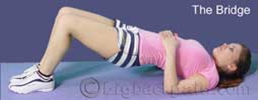
The Plank: Strengthening exercise for back, abs and neck (also strengthens arms and legs)
Lie on stomach, place elbows and forearms on floor. In a push-up position, balance on your toes and elbows. Keep your back straight and legs straight. (Like a plank) Tighten abs. Hold position for 10 seconds. Relax. Repeat five to ten times. If this exercise is too difficult (as it often is for beginners), balance on your knees instead of your toes.
 Remember to Breathe!
Remember to Breathe!
The Side Plank: Strenghtens the obliques (side abdominal muscles)
Lie on right side. Place right elbow and forearm on floor. Tighten abs. Push up until shoulder is over elbow. Keep your body in a straight line – feet, knees, hips, shoulders, head aligned. Only forearm and side of right foot are on floor (feet are stacked). Hold position for 10 seconds. Relax. Repeat five times. Repeat on left side. If this exercise is too difficult, balance on stacked knees (bend knees and keep feet off floor) instead of feet.
NOTE: The Plank and Side Plank are challenging exercises for beginners. Start with the easier version (balancing on knees). Beginners should also start with fewer repetitions to avoid muscle strain.
The Wall Squat: Strengthening exercise for back, hips and quads
Stand with your back against a wall, heels about 18 inches from the wall, feet shoulder-width apart. Tighten abs. Slide slowly down the wall into a crouch with knees bent to about 90 degrees. If this is too difficult, bend knees to 45 degrees and gradually build up from there. Count to five and slide back up the wall. Repeat 5 -10 times.
Note: Adjust distance of heels from wall so that knees are lined up over ankles when knees are bent to 90 degrees.
Leg and arm raises: Strengthening exercise for back and hip muscles.
Lie on stomach, arms reached out past your head with palms and forehead on floor. Tighten abs. Lift one arm (as you raise your head and shoulders) and the opposite leg at the same time, stretching them away from each other. Hold for 5 seconds and then switch sides. Repeat 5 - 10 times.
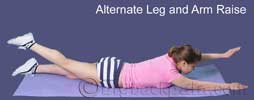
Leg lifts: Quad Strengthening Exercise
Lie flat on back. Bend left knee at 90-degree angle, keeping foot flat on floor. Tighten abs. Keep the right leg straight and slowly lift right foot to the height of the left knee. Hold for a count of 3. Do 10 repetitions. Switch sides and repeat
*Safety Tip for Leg lifts:
Lifting both legs at the same time causes excessive stress on your lower back so only lift one leg at a time; the opposite leg should be kept slightly bent with foot on floor.
Note: Crunches are Optional if you do the Plank and the Side Plank exercises (shown above).
Basic Crunches: upper abdominal exercise
Lie on back, knees bent, feet flat on floor. Do not anchor feet. (Anchoring the feet or keeping the legs straight along the floor can strain the lower back).
Head and back should be in neutral position. A rolled up towel may be placed under the natural curve of the lower back to provide extra support - the small of the back should be about an inch above the floor.
Place hands behind head with elbows pointing outward. Your hands are used to support your head (to avoid neck from tiring out before abs) but do not pull head forward.
Tighten abs.
Raise your head and shoulders off the floor - three to six inches is enough. Look at the ceiling to help prevent tilting your head. Keep elbows back.
Exhale when raising your torso off the floor and inhale when lowering.
Do ten - fifteen repetitions.
When using your hands to help support your head, be very careful not to pull on your head or you could overstretch (strain) a neck muscle!
Don't start out doing too many crunches - the number of crunches performed should be increased slowly. Stop if you experience back or neck pain. Crunches also strengthen the neck but doing too many too soon can cause neck strain.
Move slowly when performing crunches - do not rely on momentum. Only the shoulders and head are lifted off floor. Lower and mid-back should remain on the floor in neutral position (slight curve in lower back). Pelvis should not move – do not arch your back.
Rotational Crunch: obliques exercise (sides of the abdomen)
Rotational crunch is a slight variation of the regular crunch shown above. The variation - the direction you raise your head and shoulders off floor is diagonal.
Lie on back, knees bent, feet flat on floor. Do not anchor feet.
Head and back should be in neutral position.
Place hands behind head with elbows pointing outward. Your hands are used to support your head but do not pull head forward.
Tighten abs.
Rotate your body so that the weight rests on left shoulder. Raise your head and shoulders off the floor and raise your right shoulder higher than the left. Move slowly.
Exhale when raising your torso off the floor and inhale when lowering.
Do ten - fifteen repetitions.
Reverse Crunch: lower abdominal exercise
Lie flat on back, feet in the air. Bend knees 90 degrees. Place hands under buttocks for support and make sure your lower back remains flat on the floor. Tightening your lower abdomen, lift your buttocks a few inches off your hands. Hold for a moment and lower back down. Do 5 to 15 repetitions.
Leg Lifts: lower abdominal exercise
Lie flat on back. Bend left knee at 90-degree angle, keeping foot flat on floor. Tighten abs. Keep the right leg straight and slowly lift it until right foot is at the height of the left knee. Hold for a count of 5. Do 5 to 15 repetitions. Switch sides and repeat.
Backward Leg Swing: Gluteal exercise (The muscles of the buttocks help support the spine)
Stand, holding onto the back of a chair for support. Tighten abs. Swing leg back at a diagonal until you feel your buttocks tighten. Tense muscles as much as you can and swing leg back a couple more inches. Return leg to floor. Do 10 - 15 repetitions. Switch sides and repeat.
Balancing / Stability Exercises
Balancing / stability exercises also help to strengthen the deep core muscles, which are used in balancing. Doing a variety of exercises will ensure you target different muscle groups.
Opposite Arm and Leg Extension: balancing / stabilization exercise: Strengthens muscles running down sides of spine, back of shoulders, hips and buttocks
Begin on all fours, hands directly under your shoulders and knees directly under your hips.
Keep head aligned with spine (to help avoid tilting head, look at floor). Keep buttocks and abdomen tight. Do not arch the back.
Lift one arm up and forward until it is level with torso; simultaneously lift the opposite leg in the same manner. Keep arm, spine, and opposite leg aligned as if they are forming a tabletop.
Balance yourself for 10 seconds then slowly return to starting position.
Switch sides and repeat. Remember to breathe. Do five repetitions.

Exercising Using an Exercise Ball
Exercising with or without equipment is effective, but the exercise ball is often used by physical therapists. Also called the Stability Ball because you have to stabilize or balance yourself on the ball. Stability ball exercises are great for strengthening the back and abs as these core muscles are activated by the act of balancing.
Pick an exercise ball where your legs are parallel to the floor when sitting on it. Exercise balls are over inflated balls. The softer the exercise ball, the easier it is to balance on it. The further the ball is from your body, the harder the exercise. When doing exercises using an exercise ball, keep the abdomen tight.
Doing exercises with an exercise ball activates the muscles than run up and down the spine, and other deep core muscles.
Stabilization Exercises Using An Exercise Ball
The following stabilization exercises are performed while sitting on the exercise ball:
Feet flat on floor with hips and knees bent at a 90-degree angle. Tighten abs. Keep back straight.
Raise and lower one heel at a time.
Raise and lower one foot at a time a couple of inches off the floor as if marching.
Raise and lower arm, alternating sides.
Raise and lower arm while lifting opposite heel off floor.
The following stabilization exercises are performed while lying on the exercise ball:
Lie with stomach over ball. Place hands flat on floor. Tighten your abdomen and keep your back straight.
Place hands flat on floor. Walk on hands away from ball until ball is under legs. Walk back to starting position.
Place hands flat on floor. Walk on hands away from ball until ball is under legs. Slowly raise and lower alternating arms.

